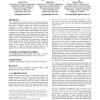Free Online Productivity Tools
i2Speak
i2Symbol
i2OCR
iTex2Img
iWeb2Print
iWeb2Shot
i2Type
iPdf2Split
iPdf2Merge
i2Bopomofo
i2Arabic
i2Style
i2Image
i2PDF
iLatex2Rtf
Sci2ools
DAC
2009
ACM
2009
ACM
Information hiding for trusted system design
For a computing system to be trusted, it is equally important to verify that the system performs no more and no less functionalities than desired. Traditional testing and verification methods are developed to validate whether the system meets all the requirements. They cannot detect the existence or show the nonexistence of the unknown undesired functionalities. In this paper, we propose a novel approach that converts this problem to a less challenging design quality measuring problem. Our approach is based on information hiding and constraint manipulation of the original system design specification. We lay out the basic requirements for our approach and demonstrate it through the popular graph coloring problem. Results show that information can be embedded into the original graph without significant impact to the solution quality. However, when the same information is added to the graph modified based on our approach, there will be noticeable drop in the solution quality. Categories ...
| Added | 19 May 2010 |
| Updated | 19 May 2010 |
| Type | Conference |
| Year | 2009 |
| Where | DAC |
| Authors | Junjun Gu, Gang Qu, Qiang Zhou |
Comments (0)

